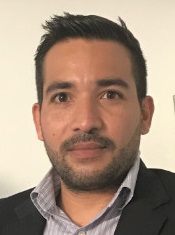At the CAPE-OPEN 2023 Annual Meeting, Cesar Pernalete Pina from the University of Gent, will present the First principles PRocess concepts for the conversion of complex MixturEs (PR1ME) as CAPE OPEN tool. He will address the challenges and opportunities.

César is a Chemical Engineer with a Master degree in System Modeling and Simulation. Currently focused on microkinetics for hydrocracking. Chemical Process Simulation and Optimization as well as Data Analytics are my main areas of work. I like to solve problems via modeling and simulation for research, operations, design or planning activities in the crude oil refining industry.
Abstract
Microkinetic modelling of chemical reactions represents an innovative approach to comprehensively account for all elementary steps involved in the considered transformations, leading to a thorough understanding of the underlying reaction mechanism. The Single-Event MicroKinetics (SEMK) variant enables the application of such a fundamental methodology towards complex mixtures, in which transformations occur through a limited number of reaction families. SEMK finds practical application in simulating processes with vast reaction networks, such as hydrocracking, hydrotreating and catalytic cracking, originally mainly in the context of fossil resources [1,2], at present also in the framework of renewable and circular feedstocks [3,4].
When dealing with complex mixtures, such as fossil hydrocarbon mixtures, renewables, and plastics-derived oils, the exact molecular composition is typically unknown, posing a challenge in applying the SEMK methodology to reactive processes involving these feeds. To overcome this limitation, molecular reconstruction (MR) techniques have been developed to determine molecular representations of such mixtures based on readily measured bulk properties [5]. The Laboratory for Chemical Technology at Ghent University, Belgium, has developed two software modules to implement the SEMK and MR methodologies.
PR1ME is a simulation framework that seamlessly integrates the SEMK and MR modules, presenting a powerful approach to innovative hydroprocessessing [6]. Its implementation within commercial process simulators is currently under exploration, and it holds the promise of allowing users to probe the reactive section of a specific process and facilitate seamless integration with upstream and downstream unit operations. Additionally, being a plug-and-play software module in process simulators, PR1ME empowers users to conduct plant-wide studies with a strong fundamental basis across different simulation platforms.
In this presentation, we introduce the architecture of PR1ME as a simulation framework and explore various approaches to make it compatible with plant-wide simulation platforms using the CAPE OPEN standards. By adopting CAPE OPEN standards, PR1ME aims to enhance collaboration and knowledge exchange within the chemical engineering community, ensuring transparency and interoperability. The compatibility with different simulation platforms is being investigated to further expand its usability, making PR1ME a potential valuable tool for advancing innovative chemical processes in a sustainable and efficient manner.
References
[1] G.G. Martens, G.B. Marin, Kinetics for hydrocracking based on structural classes: model development and application, AIChE J. 47 (2001) 1607–1622.
[2] J. Thybaut, G. Marin, Multiscale aspects in hydrocracking: from reaction mechanism over catalysts to kinetics and industrial application, Adv. Catal. 59 (2016) 109–238.
[3] C. Pernalete Piña, K. Jacobs, F. Vermeire, K. Van Geem, and J. Thybaut, The role of hydroconversion in a circular economy : processing of fossil and polymer-based mixtures, in CTS-2021, Chemical Technology Symposium, Proceedings, Ghent, Belgium, 2021.
[4] Yannick Ureel, Maarten R. Dobbelaere, Oğuzhan Akin, Robin John Varghese, César G. Pernalete, Joris W. Thybaut, Kevin M. Van Geem, Active learning-based exploration of the catalytic pyrolysis of plastic waste, Fuel, Volume 328, 2022.
[5] S. Pyl, Z. Hou, K. Van Geem, M.-F. Reyniers, G. Marin, M.T. Klein, Modeling the composition of crude oil fractions using constrained homologous series, Ind. Eng. Chem. Res. 50 (2011) 10850–10858.
[6] C. Pernalete, J. Ibañez, P. Mendes, K. M. Van Geem, , J. W. Thybaut, Hydrocracking of complex mixtures: From bulk properties, over fundamental kinetics to detailed product composition, Catalysis Today. 378 . (2021) 189-201
